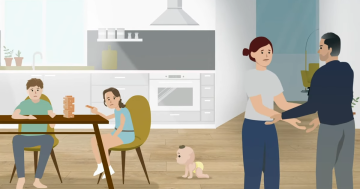
Could our courts do more to help stem the tide of family and domestic violence? Photo: Michelle Kroll.
Each case of family and domestic violence is different, but when a case ends up in court, it’s usually quite late in the story. So what role does our judicial system play, and can our courts do more to tackle this plague?
According to Law Council of Australia Family Law Section Executive Chair and DDCS Lawyers partner Di Simpson, Australian courts are increasingly aware and committed to improving their understanding and response, but the system is far from perfect. For starters, courts are usually looped into the story after damage has already been done.
“We’re a country where the treatment of women and children in our homes and communities is, at times appalling, and so much is occurring before it gets anywhere near a court,” she said.
But this space is evolving – Ms Simpson pointed to the national rollout of the Lighthouse family violence and safety initiative as evidence. A process that kicks in when a case is first brought to court, it involves risk screening, triage and case management to determine urgency and shape the allocation of resources.
But for immediate protection, an at-risk person must turn to law enforcement and the Magistrates Court process to respond quickly. In most cases they can secure an interim family violence order (FVO) the day they apply, on an “ex parte” basis (meaning not all parties involved in the dispute are required to be present).
“It’s a good system, but it’s not perfect and could be improved by ensuring that the people dealing with those matters are really immersed in family violence training and continuing to be trained,” Ms Simpson said.
“Fortunately, this is an area of focus for the courts. Judges, magistrates and judicial registrars are undergoing continual training on how to understand and to respond to clients’ experiences of family violence.
“Nobody likes dealing with family violence matters – it’s one of the hardest jobs under the remit. It’s distressing, it can be disheartening and if you get it wrong, it can result in terrible consequences. However, it’s a core part of our world and practice and we have to continue the education process, to ensure we’re not making assumptions about what we know.”

DDCS Lawyers’ Di Simpson says ongoing training for anyone dealing with family and domestic violence in the courts is critical. Photo: Region.
Courts can also be hamstrung by certain policy at times. This is a necessity to preserve justice but sometimes, even when an area of obvious improvement is identified, change can be frustratingly slow.
One example is the National Domestic Violence Order Scheme, which ensures a FVO issued in any state is nationally recognised. It was only rolled out in 2017 despite the technology being long available and many years of discussion between states, territories and the Commonwealth.
Another example is the Family Law Amendment (Information Sharing) Bill 2023 currently before the Senate. This bill would provide for state and territory welfare agencies and police to share information pertaining to safety directly to the family law courts.
“It’s a way of ensuring that when a court is dealing with risk to family violence victims, they’re receiving relevant information direct from the source and right at the start,” Ms Simpson explained.
“The discussions leading to this change were in play for at least five years.”
Ms Simpson also pointed to the limitations of the courts when dealing with more complex aspects of abuse, such as coercive control.
“There can be occasions when the complexity of what a victim is experiencing is not properly understood by the court,” she said.
“The power and control aspects to family violence can be much harder to establish, and the response from the court can sometimes leave the victim bewildered … Regrettably, there still can be cases of ‘he hasn’t hit you yet’.”
But even when a case is cut and dry, it’s rarely a question of delivering swift and effective justice. More could be done to make orders more accessible to those seeking legal protection, according to the head of Legal Aid ACT’s Early Intervention Practice Amy Begley.
“It’s a big step for someone experiencing domestic or family violence to step into a court building and apply for a family violence order [FVO],” she said.
“These orders need to be accessible, with access to the court being as simple, quick and inexpensive as is consistent with justice. One of the ways that this could be achieved is to enable people seeking protection to apply for an FVO from a location other than the court building. Whilst in some circumstances it is currently possible to seek an order from another location, it’s something we could improve.
“That ability to apply from a safe place would make these orders increasingly accessible to more people experiencing family violence.”
Ultimately however, the critical function of issuing protection orders and hearing criminal charges (including family violence offences) are pieces of a much bigger puzzle.
“I think we all know family and domestic violence is a whole-of-society issue.”





















